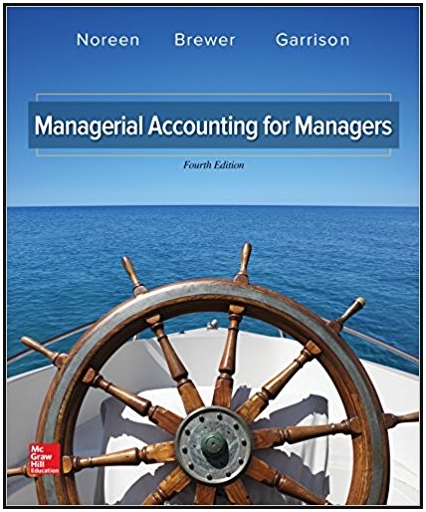Question
Hi-Tek Manufacturing, Incorporated, makes two types of industrial component parts-the B300 and the T500. An absorption costing income statement for the most recent period
Hi-Tek Manufacturing, Incorporated, makes two types of industrial component parts-the B300 and the T500. An absorption costing income statement for the most recent period is shown: Hi-Tek Manufacturing Incorporated Income Statement Sales Cost of goods sold Gross margin Selling and administrative expenses Net operating loss $ 1,776,400 1,219,870 556,530 600,000 $ (43,470) Hi-Tek produced and sold 60,400 units of B300 at a price of $21 per unit and 12,700 units of T500 at a price of $40 per unit. The company's traditional cost system allocates manufacturing overhead to products using a plantwide overhead rate and direct labor dollars as the allocation base. Additional information relating to the company's two product lines is shown below. Direct materials Direct labor Manufacturing overhead Cost of goods sold B300 $ 400,800 $ 120,500 7500 $ 162,100 $ 42,300 Total $ 562,900 162,800 494,170 $ 1,219,870 The company has created an activity-based costing system to evaluate the profitability of its products. Hi-Tek's ABC implementation team concluded that $58,000 and $108,000 of the company's advertising expenses could be directly traced to 8300 and T500, respectively. The remainder of the selling and administrative expenses was organization-sustaining in nature. The ABC team also distributed the company's manufacturing overhead to four activities as shown below: Activity Cost Pool (and Activity Measure) Machining (machine-hours) Setups (setup hours) Product-sustaining (number of products) Other (organization-sustaining costs) Total manufacturing overhead cost Manufacturing Overhead $ 206,010 127,160 Activity B300 90,400 7500 Total 62,200 79 100,800 1 210 1 152,600 289 2 60,200 NA NA NA $494,170 Activity Cost Pool (and Activity Measure) Machining (machine-hours) Setups (setup hours) Product-sustaining (number of products) Other (organization-sustaining costs) Total manufacturing overhead cost Manufacturing Overhead Activity B300 T500 $ 206,010 127,160 90,400 62,200 Total 152,600 79 210 289 100,800 1 1 2 60,200 NA NA NA $ 494,170 Required: 1. Compute the product margins for the B300 and T500 under the company's traditional costing system. 2. Compute the product margins for B300 and T500 under the activity-based costing system. 3. Prepare a quantitative comparison of the traditional and activity-based cost assignments. Complete this question by entering your answers in the tabs below. Required 1 Required 2 Required 3 Compute the product margins for the B300 and T500 under the company's traditional costing system. (Round your intermediate calculations to 2 decimal places and final answers to the nearest whole dollar amount.) Product margin B300 T500 Total $ Required 1 Required 2 > Activity Cost Pool (and Activity Measure). Machining (machine-hours) Setups (setup hours). Product-sustaining (number of products) Manufacturing Overhead $ 206,010 127,160 100,800 Other (organization-sustaining costs) Total manufacturing overhead cost Activity B300 90,400 T500 62,200 Total 152,600 79 210 289 1 1 2 60,200 NA NA NA $ 494,170 Required: 1. Compute the product margins for the 8300 and T500 under the company's traditional costing system. 2. Compute the product margins for B300 and T500 under the activity-based costing system. 3. Prepare a quantitative comparison of the traditional and activity-based cost assignments. Complete this question by entering your answers in the tabs below. Required 1 Required 2 Required 3 Compute the product margins for 8300 and T500 under the activity-based costing system. (Negative product margins should be indicated by a minus sign. Round your intermediate calculations to 2 decimal places.) Product margin B300 T500 Required 1 Required 2 Required 3 Prepare a quantitative comparison of the traditional and activity-based cost assignments. (Round your intermediate calculations te places and "Percentage" answers to 1 decimal place and and other answers to the nearest whole dollar amounts.) Traditional Cost System Amount B300 % of Amount T500 % of Total Amount Total cost assigned to products $ 0 $ 0 $ O Total cost $ 0 8300 T500 % of % of Total Amount Total Total Amount Amount Amount Amount Activity-Based Costing System Direct costs: Indirect costs: Prev 1 of 11 Next > Homework Saved Total cost assigned to products $ 0 $ 0 $ 0 Total cost Activity-Based Costing System Direct costs: Indirect costs: B300 T500 $ 0 % of % of Total Amount Total Amount Amount Amount Total Amount Total cost assigned to products Costs not assigned to products: $ 0 $ 0 0 Total cost A MacBook Pr $ 0
Step by Step Solution
There are 3 Steps involved in it
Step: 1

Get Instant Access with AI-Powered Solutions
See step-by-step solutions with expert insights and AI powered tools for academic success
Step: 2

Step: 3

Ace Your Homework with AI
Get the answers you need in no time with our AI-driven, step-by-step assistance
Get Started








